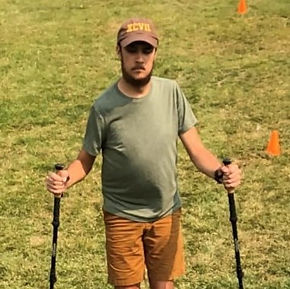Walking Stick Attachments
Overview
I worked on a solo, independent design project developing a walking stick attachment to help people with muscle anomalies climb hills easier. I was looking to do an engineering project to help me refresh my engineering skills while applying human experience to the design process. I have an undiagnosed neuromuscular disorder and know a product that solves this physical mobility problem will make a huge difference in people’s lives, including my own. For me this walking stick attachment would help me hike in the Rocky Mountains and would even facilitate my daily neighborhood walks. This project not only puts a smile on my face but also demonstrates the additive value of incorporating human factors into engineering design.
Research Phase
I started the process by conducting research into the muscles that are used normally and the muscles that I and other people with muscle disorders use instead when climbing a hill. This research included review of not only web-based articles but also a field study comparing an average person’s climbing process on a neighborhood hill and mine. By watching and re-watching the videos of both of us climbing the same hill in the same conditions, I was able to identify the different ways we each positioned our bodies and used our muscles to climb and began to formulate the project’s needed design components. I decided to use walking sticks as the foundation of the product by creating an apparatus that fits on typical sticks. By using walking sticks, an acceptable and easy to find hiking tool as the primary part of my apparatus, it will reduce the societal stigma associated with using the device.

Pictured: Me Coming Down the Hill
I Conducted my Field Study on
Community Outreach
In conjunction with my research phase, I reached out to neurologists and physical therapists at Children’s Hospital Colorado for their feedback and ideas. They validated my initial research conclusions, and my initial ideas. They also provided additional resources and some ideas on probable features necessary to make climbing easier. The neurologists offered to test my prototype with some patients when the time is right, a very exciting opportunity I will not pass up. Working on this project and engaging my local children’s hospital and its patient community is opening my eyes to how I can, in partnership with the community, build devices with a positive impact.
Future Work
In the next step of my project, I will form CAD models of the apparatus and make a prototype. My goals for the prototype include creating an easy to use low-cost product that attaches easily to walking sticks. I intend to create this prototype using a 3-D printable SolidWorks design. I will probably go through several iterations and certainly run numerous tests of my own ending with a test group in the patient community at Children’s Hospital.
After the protype phase is complete, I plan to finalize my design, put the finishing touches on the product and put my product out in a public market or distribute the walking sticks attachment through hospitals to people who will benefit from using them. Hopefully, it will help others live better both emotionally and physically.
